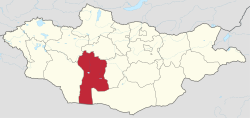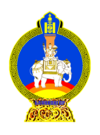Bayankhongor Province
|
Bayankhongor Province Баянхонгор аймаг ᠪᠠᠶ᠋ᠠᠩᠬᠣᠩᠭ᠋ᠤᠷᠠᠶᠢᠮᠠᠭ |
|||
|---|---|---|---|
| Province | |||
|
|||
 |
|||
| Coordinates: 46°06′N 100°41′E / 46.100°N 100.683°ECoordinates: 46°06′N 100°41′E / 46.100°N 100.683°E | |||
| Country | Mongolia | ||
| Established | 1941 | ||
| Capital | Bayankhongor | ||
| Area | |||
| • Total | 115,977.80 km2 (44,779.28 sq mi) | ||
| Population (2011) | |||
| • Total | 76,085 | ||
| • Density | 0.66/km2 (1.7/sq mi) | ||
| Time zone | UTC+8 | ||
| Area code(s) | +976 (0)144 | ||
| ISO 3166 code | MN-069 | ||
| Vehicle registration | БХ_ | ||
| Website | www |
||
Bayankhongor (Mongolian: Баянхонгор, literally Rich Darling) is one of the 21 aimags (provinces) of Mongolia. It is located in the southwest of the country and, at 116,000 square kilometers, it is one of the largest aimags. The capital of the aimag shares the provincial name, Bayankhongor.
Bayankhongor aimag was formed in 1941 with the establishment of the Bayankhongor Citizen's Assembly. There were originally 16 Bayankhongor Area Soums and about 41 thousand people in the aimag. The aimag was originally named Govi-Bumbugur, however it was soon changed to Bayankhongor.
In April 1976, Bayankhongor was awarded the Outstanding Red Award for livestock, meat, and wool production. The aimag received substantial investment from the former USSR, including infrastructure and education. However, the USSR also systematically repressed the religion and cultural heritage of the aimag, purging famous monasteries such as the Geegin Monastery and killing thousands of monks.
The zud, winter snow disasters, of the early 2000s devastated Bayankhongor’s livestock and economy. The zud also precipitated social changes in the aimag since fewer people now rely on herding as a major source of income and more people have moved to the aimag capital in search of work. Out of the total aimag population estimated at 80,000, somewhere between 25-35,000 people live in the provincial capital.
The Bayankhongor aimag includes very diverse geographic areas. It is typically divided into three areas: the mountainous and wooded Khangai in the north, the central steppe region, and the arid Gobi Desert in the south.
Bayankhongor contains two mountain ranges, the Khangai Mountains in the north and the Gobi Altai Mountains in the central region. Ikh Bogd, the aimag’s tallest mountain at 3957 meters, is part of the Gobi Altai range and is located outside of Bogd sum.
The largest lakes in Bayankhongor are Orog Nuur and Böön Tsagaan Nuur, which are found in the central semi-desert region of the aimag (the Valley of Lakes between the Khangai and Gobi Altai ranges), as are several other lakes. Due to the surrounding mountain areas, the lakes in the Valley of Lakes have no outlet and are therefore saline.
...
Wikipedia


